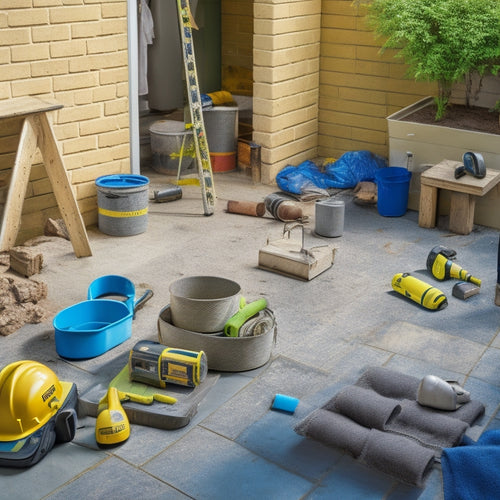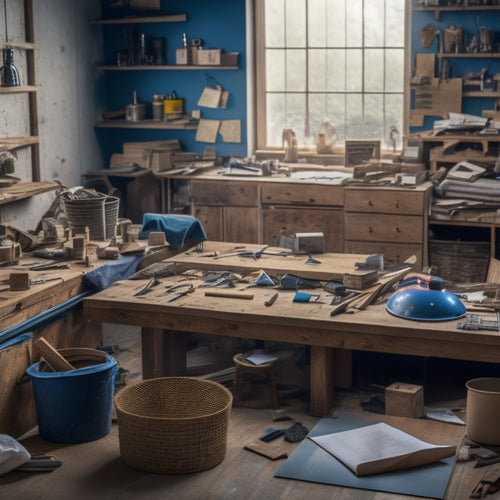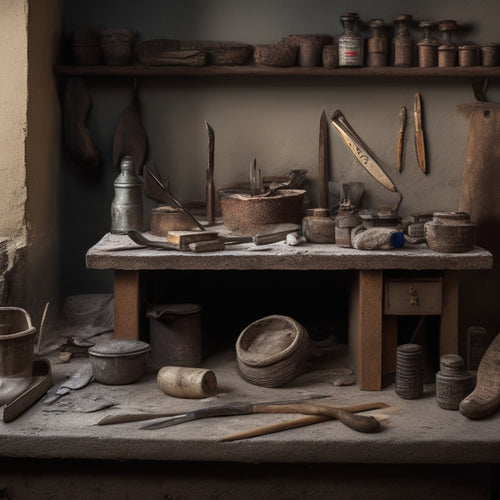
Top Jointing Tools for Home Renovation Projects
Share
When tackling a home renovation project, you'll need the right jointing tools to guarantee professional-looking results and maintain structural integrity. Essential tools include a joint cleaner, concrete saw, and tamping tool for joint preparation and repair. High-quality jointing chisels and concrete joint spacers are also vital for precise control joints and preventing cracking. Effective joint cleaning brushes, concrete grooving tools, and joint sealant guns will help you achieve a durable and watertight bond. As you explore the world of jointing tools, you'll discover more about the nuances of each tool and how they can greatly influence the success of your project.
Key Takeaways
• Essential tools for joint preparation and repair include joint cleaners, concrete saws, tamping tools, and adhesives for effective joint repairs.
• High-quality jointing chisels are necessary for removing old mortar and debris, and selecting the right chisel type is crucial for the task.
• Concrete joint spacers ensure precise control joints and prevent cracking, and their material and features should be chosen based on the project's requirements.
• Effective joint cleaning tools, such as brushes with nylon or polypropylene bristles, are necessary for thorough joint cleaning before filling and sealing.
• Joint sealant guns with pressure control, ergonomic design, and compatibility with various sealants enable accurate dispensing for watertight bonds.
Essential Tools for Concrete Joints
When working with concrete joints, you'll need a set of specialized tools to guarantee a strong and durable bond, including a joint cleaner, concrete saw, and tamping tool. These essential tools will help you achieve joint stability techniques that assure the structural integrity of your concrete structure.
A joint cleaner is used to remove dirt, debris, and old adhesive from the joint, preparing it for new materials. A concrete saw, on the other hand, is necessary for cutting through concrete to create new joints or repair existing ones. A tamping tool helps to compact and level the concrete, assuring a smooth finish.
In addition to these tools, you'll need to familiarize yourself with concrete repair methods to effectively restore damaged joints. This may involve removing damaged concrete, cleaning and preparing the joint, and applying new materials such as epoxy or polyurethane-based adhesives.
Top Rated Jointing Chisels
You'll also want to equip yourself with a high-quality jointing chisel, a versatile tool that's perfect for removing old mortar, breaking up debris, and scraping out joints in preparation for new materials.
When selecting a jointing chisel, consider the type of material you'll be working with, as well as the specific jointing techniques you'll be using. For example, a flat chisel is ideal for removing old mortar, while a pointed chisel is better suited for breaking up debris.
Proper chisel maintenance is also essential to guarantee the longevity of your tool. Regularly clean and sharpen your chisel to prevent rust and maintain its effectiveness. Additionally, store your chisel in a dry place, away from other tools to prevent damage.
Best Concrete Joint Spacers
Selecting the right concrete joint spacers is vital to achieving precise control joints and preventing cracks in your finished concrete slabs.
As you plan your home renovation project, you'll want to choose spacers that provide ideal concrete spacer benefits, such as consistent joint width, reduced shrinkage, and improved slab durability.
When it comes to spacer installation techniques, it's important to follow best practices to guarantee accurate placement and secure fastening. You'll want to take into account factors like spacer material, size, and shape, as well as the type of concrete you're working with.
For example, plastic or foam spacers are ideal for residential projects, while metal spacers are better suited for high-traffic commercial applications. Additionally, think about using spacers with built-in anchors or reinforcement for added strength and stability.
Effective Joint Cleaning Brushes
When selecting an effective joint cleaning brush for your home renovation project, you'll want to take into account the type of bristle material that will best tackle the task at hand.
You'll find that brushes with nylon or polypropylene bristles are well-suited for removing joint debris, as they're durable and resistant to abrasion.
Brush Bristle Material Matters
The choice of bristle material in your joint cleaning brush greatly impacts its effectiveness in removing old adhesive, dirt, and debris from the joint area. As you select a brush, you'll encounter various bristle materials, each with its strengths and weaknesses.
Natural bristles, such as those made from animal hair, offer excellent flexibility and are gentle on surfaces. However, they can be prone to wear and tear, affecting brush durability.
On the other hand, synthetic bristles made from nylon or polyester are more resistant to wear and can withstand harsh cleaning agents. They're also less likely to absorb moisture, reducing the risk of mold and mildew growth.
When choosing a brush, consider the type of joint and the level of dirt and debris you're dealing with. If you need a gentle touch, natural bristles might be the way to go. For tougher jobs, synthetic bristles could be the better choice.
Joint Debris Removal Ease
With effective joint cleaning brushes, you can effortlessly sweep away debris and old adhesive, guaranteeing a smooth, even surface for new materials to bond to. This vital step in the jointing process is often overlooked, but it's essential for achieving a strong, long-lasting bond. By using the right brush, you can avoid common issues like uneven surfaces, weak bonds, and even material failure.
| Brush Type | Debris Removal Techniques | Efficient Cleanup Methods |
|---|---|---|
| Stiff-bristled brush | Aggressive sweeping for large debris | Use with a vacuum for maximum efficiency |
| Soft-bristled brush | Gentle sweeping for fine particles | Use with a dusting cloth for delicate surfaces |
| Wire brush | Scrubbing for stubborn adhesive | Use with a solvent for tough residue |
When selecting a joint cleaning brush, consider the type of debris you're dealing with and the surface material you're working with. By choosing the right brush and employing efficient cleanup methods, you can guarantee a strong, reliable bond that will withstand the test of time. By mastering debris removal techniques, you'll be able to complete your home renovation project with confidence and precision.
Must-Have Concrete Grooving Tools
You'll need a concrete groover, a specialized tool designed to create controlled joints in freshly poured concrete, to prevent random cracking and guarantee a stable, durable surface. This tool is important for any concrete project, as it allows you to control the location and depth of joints, ensuring a professional-looking finish.
When it comes to grooving techniques, it's essential to follow jointing tips to achieve ideal results. For instance, you should groove the concrete when it's still fresh, but firm enough to hold the tool's weight. Apply gentle to moderate pressure, depending on the concrete's strength, and maintain a consistent pace to avoid creating uneven joints.
It's also significant to choose the right groover for your project, considering factors like the type of concrete, joint spacing, and desired joint depth. By mastering these grooving techniques and following expert jointing tips, you'll be able to create strong, durable joints that enhance the overall appearance and longevity of your concrete structure.
High-Quality Joint Sealant Guns
Sealant guns take center stage in the jointing process, as they enable you to accurately dispense sealants into freshly grooved joints, guaranteeing a watertight bond that protects your concrete structure from water damage and erosion.
When selecting a high-quality joint sealant gun, you'll want to take into account factors such as pressure control, ergonomic design, and material compatibility. Look for guns with adjustable pressure settings to make certain you can achieve the ideal flow rate for your specific sealant application techniques.
A comfortable grip and balanced design will reduce fatigue during extended use. Additionally, make sure the gun is compatible with the best sealant materials for your project, such as silicone, polyurethane, or acrylic-based sealants.
A high-quality sealant gun will also feature a durable, corrosion-resistant construction to withstand the demands of your renovation project.
Concrete Joint Filling Essentials
When preparing to fill concrete joints, you'll need to determine the best preparation method for your specific project, considering factors like cleaning and priming.
Next, you'll need to accurately measure the joint width and depth to guarantee a proper fill.
Joint Filling Preparation Methods
Before filling concrete joints, it's essential to prepare the surface by removing dirt, oil, and old sealant residues that can compromise the bonding process. You'll need to clean the joints thoroughly to guarantee a strong bond between the old concrete and the new filler material.
Use a wire brush or a joint preparation tool to scrub the joints, removing any loose material or debris. Next, use a solvent-based cleaner to dissolve and remove any oil or grease that may be present.
After cleaning, use a pressure washer to remove any remaining dirt or debris. This will help to open up the pores of the concrete, allowing for a stronger bond.
Once the joints are clean and dry, you can begin applying the joint filler material using various joint filling techniques. Depending on the type of filler you're using, you may need to use specialized joint preparation tools, such as a joint saw or a grinder, to prepare the surface.
Joint Width and Depth
As you prepare to fill concrete joints, determining the correct joint width and depth is essential, since these dimensions will considerably impact the performance and longevity of the filler material.
Joint width and depth are critical factors in ensuring the filler material effectively withstands the stresses and movements of the surrounding concrete.
When it comes to joint design considerations, you'll want to keep the following in mind:
-
Joint width: The width of the joint should be sufficient to accommodate the filler material, yet narrow enough to prevent excessive movement and cracking.
-
Joint depth: The depth of the joint should be adequate to allow for proper filling and finishing, while also ensuring the filler material doesn't overfill or spill over.
-
Joint placement techniques: The placement of joints should be strategic, taking into account the structural integrity and stress points of the surrounding concrete.
Filling Material Options
You have several filling material options to choose from, each with its own strengths, weaknesses, and suitability for specific joint applications.
When it comes to concrete joint filling, you'll need to select a material that meets the project's requirements. There are various filling material types, including epoxies, polyurethanes, and acrylics. Each type has its own unique characteristics, such as flowability, compressive strength, and bonding properties.
For instance, epoxy-based fillers are ideal for high-traffic areas and joints subject to heavy loads. They offer excellent durability and resistance to chemicals.
Polyurethane-based fillers, on the other hand, are more flexible and suitable for joints that need to accommodate movement.
Acrylic-based fillers are a popular choice for general-purpose applications, offering a balance of strength, flexibility, and affordability.
When selecting a filling material, consider factors such as joint width, depth, and substrate type. You should also think about the intended use of the joint, as well as any exposure to harsh environmental conditions.
Specialty Tools for Expansion Joints
As you tackle your home renovation project, you'll encounter various expansion joint types, each requiring precise control over the sealant's flow and finish. This is where specialty tools like injection guns and flow-control devices come into play. These tools guarantee a smooth, even application, making expansion joint maintenance a breeze.
When working with expansion joints, you'll need:
-
Injection guns: These handheld devices allow you to inject sealant into the joint with precision, guaranteeing a consistent flow and minimizing waste.
-
Flow-control devices: These tools regulate the amount of sealant released, preventing over- or under-filling, and ensuring a professional finish.
-
Nozzle extensions: These accessories enable you to reach deep into the joint, guaranteeing a thorough seal and reducing the risk of air pockets or voids.
Frequently Asked Questions
What Safety Gear Is Necessary When Working With Jointing Tools?
When operating jointing tools, you'll need to wear essential safety gear, including safety goggles to protect your eyes from debris and hearing protection, such as earplugs or earmuffs, to prevent permanent hearing damage.
Can I Use Jointing Tools on Freshly Poured Concrete?
You shouldn't use jointing tools on freshly poured concrete, as it can cause damage and compromise the structural integrity. Instead, wait until the concrete has fully cured, then employ advanced jointing tool techniques for a successful fresh concrete jointing outcome.
How Do I Store Jointing Tools to Maintain Their Quality?
When you're not wielding your trusty jointing tools, gently "tuck them in" to prevent rust and damage. For ideal storage, utilize a dry, ventilated area with individual compartments, ensuring jointing tool maintenance and prolonging their lifespan.
Are Jointing Tools Suitable for DIY Home Renovation Projects?
You'll find jointing tools suitable for DIY home renovation projects, as they enable precise jointing techniques, ensuring strong, durable connections; with practice, you'll master these skills, taking your DIY projects to the next level.
Can I Rent Jointing Tools Instead of Buying Them?
You can consider jointing tool rental as a cost-effective alternative to buying, but compare rental fees to purchase prices, factoring in usage frequency and project duration, to determine the best option for your DIY renovation needs.
Conclusion
As you wrap up your home renovation project, you're just one step away from a flawless finish.
But don't breathe a sigh of relief just yet - the final touches depend on the quality of your jointing tools.
With the right arsenal, you'll guarantee a durable, weather-tight seal that withstands the test of time.
But choose poorly, and you'll be dealing with costly repairs down the line.
The fate of your renovation hangs in the balance - will you make the cut?
Related Posts
-

7 Patio Safety Tips for DIY Renovation Projects
As you begin your DIY patio renovation project, prioritize safety by evaluating the worksite for tripping hazards and...
-

7 Best Home Renovation Project Checklists With Timelines
You're about to initiate a home renovation project, and establishing a clear plan with timelines is vital to staying ...
-

Stucco Tool Kit Checklist for Home Renovation
You'll need a thorough stucco tool kit to guarantee a successful home renovation, as the right tools can make all the...


